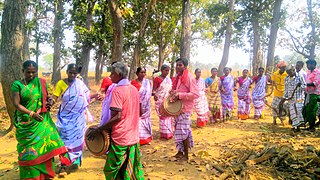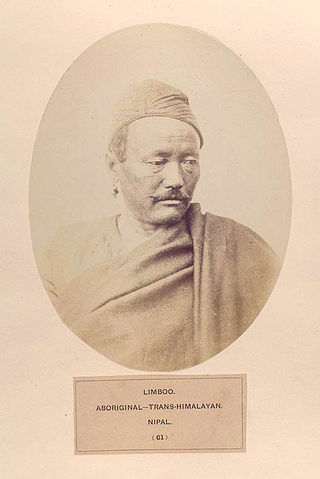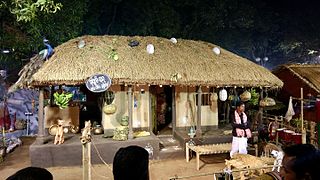
The Santal are an Austroasiatic-speaking Munda ethnic group of the Indian subcontinent. Santals are the largest tribe in the Jharkhand and West Bengal in terms of population and are also found in the states of Odisha, Bihar, Assam and Tripura. They are the largest ethnic minority in northern Bangladesh's Rajshahi Division and Rangpur Division. They have a sizeable population in Nepal. The Santals speak Santali, the most widely spoken Munda languages of Austro-asiatic language family.

Baraat or Varayatra is a groom's wedding procession in Indian subcontinent. In Indian subcontinent, it is customary for the bridegroom to travel to the wedding venue on a mare, accompanied by his family members.

The Limbu or Yakthung (endonym) are a Tibeto-Burman ethnolinguistic group indigenous to the Himalayan region of eastern Nepal, Sikkim, Assam, Nagaland, northern West Bengal, and western Bhutan.

The Kurukh or Oraon, also spelt Uraon or Dhangad, are a Dravidian speaking ethnolinguistic group inhabiting Chhotanagpur Plateau and adjoining areas - mainly the Indian states of Jharkhand, Odisha, Chhattisgarh, and West Bengal. They predominantly speak Kurukh as their native language, which belongs to the Dravidian language family. In Maharashtra, Oraon people are also known as Dhangad.

Odia cuisine is the cuisine of the Indian state of Odisha. Compared to other regional Indian cuisines, Odia cuisine uses less oil and is less spicy, while nonetheless remaining flavourful. Rice is the staple food of this region. Mustard oil is used in some dishes as the cooking medium, but ghee is preferred in temples. Odia foods traditionally served either on brass, bronze metal plates, banana leaf or disposable plates made of sal leaves.

Jharsuguda is a city and district headquarters of Jharsuguda district of Odisha, India. It is an industrial hub, consisting mainly of metallurgical industries. It is well connected to major cities of India through the rail network, and a recently inaugurated Jharsuguda Airport, now renamed as Veer Surendra Sai Airport. It is popularly known as the "Powerhouse of Odisha" due to its Mega Steel, Aluminium & Power Projects. Its First Industrialist in SSI Steel Sector of the Region was Jayprakash Badhan. Jharsuguda has often been referred as "Little India" as well because of its diverse demography, language and culture. One of the oldest bar and hotel in region is Kalinga Bar.
This article lists the traditional festivals and other cultural events in the Odisha region of India. Odisha celebrates 13 festivals in 12 months as the saying goes Bāra Māsare Tera Parba.
Mechinagar is a municipality in Jhapa District, Koshi Province, Nepal and is the main entry point from India on Nepal's eastern border. Nepal's customs office is in Kakarvitta, a section of the municipality. The city lies 475 km southeast of the capital Kathmandu and 115 km east of Biratnagar, the capital of Province No. 1.

Bhumij is a Munda ethnic group of India. They primarily live in the Indian states of West Bengal, Odisha, Assam and Jharkhand, mostly in the old Singhbhum district. Also in states like Bihar and Assam. There is also a sizeable population found in Bangladesh. Bhumijas speak the Bhumij language, an Austroasiatic language, and use Ol Onal script for writing.

The Kulung also call Kulunge are one of the major subgroup of kirati people and indigenous communities of Nepal, as well as parts of northeastern Sikkim and Darjeeling district of India, having their own Kulung language, culture, history and tradition.
Bahaghara is a wedding ceremony performed by Odia Hindu people in the Indian state of Odisha. There are subtle differences in the rites observed by different castes. In Odia marriage rituals, the mother of the bridegroom does not take part in the ceremony. The Utkala Brahmins have their weddings only in the daytime, preferably at midday or in the morning, while the other caste weddings are done during the evening or night. There is the custom of sending betel nuts to family friends for inviting them to the marriage. The first invitation is sent to the family deity as a respect to the lord. Marriages in Odisha are mostly fixed and arranged by the parents. Marriages for serving or capturing is not common.

Koya are an Indian tribal community found in the states of Andhra Pradesh, Telangana, Chhattisgarh, and Odisha. Koyas call themselves Koitur in their dialect. The Koyas speak the Koya language, also known as Koya basha, which is a Dravidian language related to Gondi.
Buddhashanti is a rural municipality (gaunpalika) out of seven rural municipality located in Jhapa District of Koshi Province of Nepal. Buddhashanti, according to Ministry of Federal Affairs and Local Development has an area of 79.78 square kilometres (30.80 sq mi) and the total population of the municipality is 41,615 as of Census of Nepal 2011.
Kanwar or Kawar is a tribal community found in central India, mainly in the state of Chhattisgarh, with significant populations in neighbouring areas of Maharashtra and Madhya Pradesh.

The Bathudi or Bathuri is a community found mainly in the north western part of Odisha. Some Bathudis, however migrated to neighbouring states of Jharkhand and West Bengal. The 2011 census showed their population to be around 220,859. They are classified as a Scheduled Tribe by the Indian government.
The Sounti are an Indo-Aryan ethnic group found mainly in the Kendujhar and Mayurbhanj districts of Odisha. The 2011 census showed their population to be around 112,803. They are classified as a Scheduled Tribe by the Indian government.
The Kora are an ethnic group found in the Indian states of West Bengal, Odisha and Jharkhand and the Bangladeshi division of Rajshahi. The 2011 census showed their population to be around 260,000. They are classified as a Scheduled Tribe by the Indian government.
The Binjhal is an ethnic group and an offshoot of the Austroasiatic Baiga tribe, are found mainly in many districts of Odisha, Chhatishgarh, Madhya Pradesh and Maharashtra. The 2011 census showed their population to be around 137,040. They are classified as a Scheduled Tribe by the Indian government.

Casearia graveolens is a species of tree in the family Salicaceae, native to an area in Asia from Thailand to South Central China to Pakistan. The plant is used in fishing, fuel, medicine, as a source of non-edible oil, in construction and as food.
The Ganda or Gandawa are an indigenous community from the eastern Indian states of Odisha and Chhattisgarh. They live mainly in western Odisha and adjoining parts of Chhattisgarh, especially in Bolangir and Bargarh districts. They are divided into various endogamous divisions such as Odia, Laria, Kandria/Kandharia, Kabria and Saharia Ganda, which are further divided into a number of totemistic exogamous clans like bagh,sika, nag, and podha. They practise adult marriage and are mainly monogamous. Marriages are usually arranged through negotiation, while mutual consent is also respected. junior levirate, junior sororate, remarriage of widows, widowers, and divorcees are permitted. They follow the puberty function and have birth pollution. Pre-delivery and post natal rituals such as chatti, naming ceremony, and tonsure are also performed. They practise both cremation and burial to dispose of their dead. Their traditional occupations includes weavers ,village watchmen and village headmen. They also play drums during special occasions. Their principle deity is Dulha Deo.











